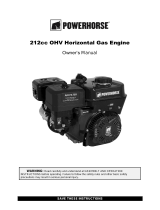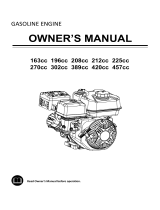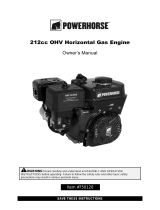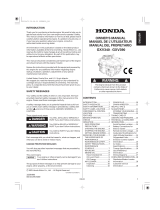Page is loading ...


Thank you for purchasing
a
Honda engine.
This manual covers
the
operation and maintenance
of
GXI
20
and GXI
60
eng~ines and is based on GXI
60
engine. The QXE type is equipped for both
electric and manual starting; other types are equipped for manual starting
onl$. All information in this publication
is
based on the latest product infor-
mation available
at
the time of printing.
Horjda Motor Co., Ltd. reserves the right to make changes
at
any time
without notice and without incurring any obligation.
No part of this publication may be reproduced without written permission.
This manual should be considered
a
permanent part of the engine and
should remain with the engine if
it
is resold.
It
is^
illegal in some areas to operate
an
engine without
a
U.S.D.A. qualified
spa~rk arrester; check local laws and regulations. An optional spark arrester
for this engine is available from any dealership displaying the Honda Power
Equipment Engines sign.
READ
THIS
OWNER’S
MANUAL
CAREFULLY.
Pay special attention to
these symbols and any instructions that follow:
-Indicates serious injury or death
WILL
result if
,
instructions are not followed.
-Indicates a strong possibility that serious injury or
death could result if instructions are not followed.
-Indicates a possibility that minor injury can result if
~
instructions are not followed.
-1
-Indicates that equipment or property damage can
result if instructions are not followed.
NOTE: Gives helpful information.
If alproblem should arise, or if you have any questions about your engine,
consult your Honda engine dealer.

CONTENTS
1
.
ENGINE SAFETY
.................................................................
3
2
.
COMPONENT IDENTIFICATION
.............................................
4
3
.
BATTERY CONNECTIONS (for electric starter)
.........................
5
4
.
REMOTE CONTROL LINKAGE
................................................
6
5 .
PRE-OPERATION CHECK
......................................................
7
1
.
ENGINE
OIL
....................................................................
7
2
.
REDUCTION GEAR
OIL
.....................................................
8
3
.
AIR CLEANER
.................................................................
9
4
.
FUEL
.............................................................................
11
GASOLINE CONTAINING ALCOHOL
...................................
12
6
.
STARTING THE ENGINE
.......................................................
13
7
.
OPERATION
.......................................................................
16
Oil Alert System
..............................................................
17
8
.
STOPPING THE ENGINE
.......................................................
18
High altitude operation
.....................................................
19
9
.
MAINTENANCE
..................................................................
20
1
.
Oil change
......................................................................
21
2
.
Air cleaner service
...........................................................
22
3
.
Sediment cup cleaning
.....................................................
25
4
.
Spark plug service
...........................................................
26
5 .
Spark arrester maintenance
...............................................
28
6
.
Carburetor adjustment
.....................................................
29
10
.
TRANSPORTING/STORAGE
..................................................
30
I1
.
TROUBLESHOOTING
...........................................................
31
12
.
SPECIFICATIONS
................................................................
33
13
.
WIRING DIAGRAM
..............................................................
34
14
.
WARRANTY SERVICE
..........................................................
36
2

I.
ENGINE
SAFETY
eonda engines are designed to give safe and dependable service
if
oper-
ated according to instructions. Read and understand this Owner’s
Manual before operating the engine. Failure to do
so
could result
in
per-
sonal injury or equipment damage.
To
prevent fire hazards and to provide adequate ventilation, keep the
engine at least
1
meter
(3
feet) away from buildings and other equip-
ment during operation.
Do
not place flammable objects close to the
engine.
Children and pets must be kept away from the area of operation due to
a
possibility of burns from hot engine components or injury from any
equipment the engine may be used to operate.
Know how to stop the engine quickly, and understand the operation of
all controls. Never permit anyone to operate the engine without proper
instructions.
Gasoline is extremely flammable and is explosive under certain
conditions.
Refuel
in
a well-ventilated area
with
the engine stopped.
Do
not smoke
or allow flames or sparks
in
the refueling area or where gasoline is
stored.
Do
not overfill the fuel tank. After refueling, make sure the tank cap is
closed properly and securely.
Be careful not to spill fuel when refueling. Fuel vapor or spilled fuel may
i,gnite.
If
any fuel is spilled, make sure the area is dry before starting the
engine.
Never run the engine
in
an enclosed or confined area. Exhaust contains
poisonous carbon monoxide gas; exposure may cause
loss
of con-
sciousness and may lead to death.
The muffler becomes very hot during operation and remains hot for a
while after stopping the engine. Be careful not to touch the muffler
while
it
is hot.
To
avoid severe burns or fire hazards, let the engine cool
before transporting
it
or
storing
it
indoors.
3

2.
COMPONENT IDENTIFICATION
MUFFLER THROTTLE LEVER
OIL ALERT LAMP
ENGINE SWITCH
SPARK PLUG (QXE type)
AIR CLEANER CIRCUIT BREAKER
(QXE type)
CHOKE LEVER RECOIL STARTER
OIL ALERT LAMP
FUEL
VALVE
I
STARTER GRIP
FUEL FILLER CAP
SERIAL NUMBER AND
ENGINE TYPE
OIL DRAIN PLUG OIL FILLER CAP
ENGINE
SWITCH
QXS type
,
ELECTRIC STARTER
(QXE type)
Record the engine model, type and serial number information for your
reference. Refer to this information when ordering parts,
and
when mak-
ing technical or warranty inquiries (see page
36).
Engine model type and serial number:
4

3.
BATTERY CONNECTIONS
(for
electric
starter)
Use
a
12
volt battery
with
an ampere-hour rating
of
at least
18
AH.
Connect the battery positive
(+)
cable to the starter solenoid terminal, as
shown.
Connect the battery negative
(-1
cable to an engine mounting bolt, frame
bolt, or other good engine ground connection.
Check the battery cable connections to be sure the cables are secured and
free
of
corrosion. Remove any corrosion
and
coat the terminals and cable
l
ends
with
grease.
,STARTER
SOLENOID
'
POSITIVE
(+I
BATTERY
CABLE
the battery gives off explosive gases; keep sparks, flames and cigaret-
tes away. Provide adequate ventilation when charging or using bat-
keries
in
an enclosed space.
The battery contains sulfuric acid (electrolyte). Contact
with
skin
or
pyes may cause severe burns. Wear protective clothing and a face
Fhield.
!-
If
electrolyte gets on your skin, flush
with
water.
~-
If
electrolyte gets
in
your eyes, flush
with
water for at least
15
~
minutes and call a physician immediately.
~-
If
swallowed, drink large quantities of water or milk and follow
with
I
milk
of magnesia or vegetable oil and call a physician.
0
Electrolyte is poisonous.
!KEEP OUT
OF
REACH
OF
CHILDREN.
I
NOTICE
I
0
use
only distilled water
in
the battery. Tap water
will
shorten the ser-
vice
life of the battery.
filling
the battery above the UPPER LEVEL line may cause the elec-
~trolyte to overflow, resulting
in
corrosion to engine or nearby parts.
~lmmediately wash off any spilled electrolyte.
0
be
careful not to connect the battery
in
reverse polarity, as this
will
;short circuit the battery charging system.

4.
REMOTE
CONTROL
LINKAGE
(for
throttle
and
choke
cables)
The throttle and choke control levers are provided
with
holes for optional
cable attachment. The following illustrations show installation examples
for a solid wire cable and for a braided wire cable.
If
using a braided wire
cable, add a return spring as shown.
It
is necessary to loosen the throttle lever friction
nut
when operating the
throttle
with
a remote cable.
[Remote throttle]
THROTTLE LEVER
PIVOT NUT
Y
Flexible wire core
4
mm SCREW
WIRE WIRE HOLDER
mounting
[Remote choke1
THROTTLE
LEVER
’
OPTIONAL
WIRE HOLDER
.
CHOKE LEVER
6

5.
PRE-OPERATION CHECK
I.
ENGINE
OIL
I
NOTICE
1
Engine oil is a major factor affecting engine performance and service
Be sure to check the engine on a level surface with the engine stopped.
life. Non-detergent oils and vegetable oils are not recommended.
i
Use Honda 4-stroke oil or an
equivalent high-detergent, premium
quality motor oil certified to meet or
exceed U.S. automobile manufac-
I
2OW-40.2OW-56
I
1
I
turer's requirements for Service
Cla'ssification SG.SF/CC.CD. Motor
oils classified SG.SF/CC.CD. will
show this designation on the con-
I
I
tairjer.
SAE
IOW-30
is recommended for
-30
-20
-lo
lo
2o
30
40"c
-20
0
20
40
60 80
100°F
I
1
I
general, all-temperature use.
Ambient temperature
Other viscosities shown
in
the chart
may be used when the average
temperature
in
your area is
within
the
indicated range.
1.
Remove the oil filler cap and wipe the dipstick clean.
2.
l~nsert the dipstick into the oil filler neck
but
do not screw
it
in.
3.
Iif
the level is
low,
fill to the top of the oil filler neck
with
the recom-
mended oil.
Running the engine with insufficient oil can cause serious engine
damage.
OIL
FILLER
CAP
7

2.
REDUCTION GEAR
OIL
(Only on equipped model)
<I
/2
reduction with automatic centrifugal clutch>
1.
Remove the oil filler cap and wipe the dipstick clean.
2.
Insert the dipstick into the filler neck but do not screw
it
in.
3.
If
the level is
low,
fill to the upper level mark
with
the same oil recom-
mended
for
the engine (see engine oil recommendations on page
7).
Oil capacity:
500
cc
(1
7
US
02,
14
ImD
02)
UPPER
LEVEL
<
1
/6
reduction>
1.
Remove the oil level bolt.
p=-y
DIPSTICK/FILLER
CAP
DRAIN
BOLT
2.
Check the oil level;
it
should reach the edge of the oil level bolt hole. If
the oil level is low, remove the filler bolt, and add
oil
until
it
starts to
flow out the
oil
level bolt hole. Use the same oil recommended for
the
engine (see engine oil recommendations on page
7).
3.
Install the oil level bolt and filler bolt. Tighten them securely.
Oil capacity:
150
cc
(5.1
US
02,
4.2
Imp
02)
OIL LEVEL
BOLT
FILLER
BOLT

3.
AIR
CLEANER
Never run the engine without the air cleaner. Rapid engine wear
will result from contaminants, such as dust and dirt, being drawn through
the: carburetor and into the engine.
'I
<Dual element type>
Check the air cleaner elements to be
..'
sur~e they are clean and
in
good con-
diti~on. Clean or replace the elements
if necessary (p.22).
<Cbclone type>
1.
2.
Check the air cleaner element to
be sure they are clean and
in
good
condition.
Flean or replace the elements
if
necessary (p.23).
Check the cyclone housing, and
clean
it
if
it
is
clogged or ex-
cessively dirty (p.23).
ELEMENTS
CYCLONE
-
HOUSING
ELEMENTS

4.
FUEL
Your engine is designed to use any gasoline
that
has
a
pump octane
number
(
‘2
)
of
86
or higher, or
that
has
a
research oc-
tanle number of
91
or higher. Gasoline pumps
at
service station normally
display the pump octane number.
We
recommend that you use unleaded fuel because
it
produces fewer
engine and spark plug deposits and extends the life
of
exhaust system
components.
NeGer use stale or contaminated gasoline or an oil/gasoline mixture. Avoid
getring dirt, dust or water in the fuel tank. Use of
a
lower octane gasoline
can cause persistent “pinging” or heavy ”spark knock”
(a
metallic rapp-
ing:noise) which, if severe, can lead to engine damage.
If ”spark knock” or “pinging” occurs at a steady engine speed
under normal load, change brands of gasoline.
If
spark knock or pinging
persists, consult your authorized Honda dealer. Failure to do
so
is con-
sidered misuse, and damage caused by misuse is not covered by Honda’s
Limited Warranty.
OcCasionally you may experience light spark knock while operating under
heavy loads. This is no cause for concern,
it
simply means your engine is
operating efficiently.
Gasoline is extremely flammable and is explosive under certain
conditions.
Refuel
in
a well-ventilated area
with
the engine stopped.
Do
not smoke
or allow flames or sparks
in
the area where the engine is refueled or
where gasoline is stored.
Do not overfill the fuel tank (there should be no fuel
in
the filler neck).
After refueling, make sure the tank cap is closed properly and securely.
Be careful not to spill fuel when refueling. Spilled fuel or fuel vapor may
ibnite. If any fuel is spilled, make sure the area is dry before starting the
engine.
Avoid repeated or prolonged contact
with
skin
or
breathing of vapor.
KEEP OUT OF REACH OF CHILDREN.
Fuel tank capacity: GX120
:
2.5
L‘
(0.66
US Gal,
0.55
Imp Gal.)
GX160
:
3.6
L‘
(0.95
US Gal,
0.79
Imp Gal.)
11

GASOLINES CONTAINING ALCOHOL
If you decide to use
a
gasoline containing alcohol (gasohol), be sure its oc-
tane rating is
at
least as high as that recommended by Honda. There are
two types of "gasohol": one containing ethanol, and the other containing
methanol.
Do
not use gasohol that contains more than
10%
ethanol.
Do
not use gasoline containing methanol (methyl or wood alcohol) that does
not also contain cosolvents and corrosion inhibitors for methanol. Never
use gasoline containing more than
5%
methanol, even if
it
has cosolvents
and corrosion inhibitors.
NOTE:
Fuel system damage or engine performance problems resulting from the
use of fuels that contain alcohol is not covered under the warranty.
Honda cannot endorse the use of fuels containing methanol since
evidence of their suitability is as yet incomplete.
Before buying fuel from an unfamiliar station, try to find out if the fuel
contains alcohol, if
it
does, confirm
the
type and percentage of alcohol
used. If you notice any undesirable operating symptoms while using
a
gasoline that contains alcohol, or one that you think contains alcohol,
switch to
a
gasoline
that
you know does not contain alcohol.
12

6.
STARTING THE ENGINE
1.
Turn the fuel valve to the
ON
position.
FUEL VALVE
2.
Move the choke lever to the
CLOSE
position.
NOTE:
The choke may not be needed
if
the engine is warm
or
the air
temperature is high.
CHOKE LEVER
13

~~ ~
3.
Move the throttle lever slightly to the left.
THROTTLE LEVER
4.
Start the engine.
0
With recoil starter:
Turn the engine switch to the
ON
position.
ENGINE
SWITCH
(Type with electric starter and
oil alert system)
14

Pull
the starter grip lightly until resistance is felt,
then
pull briskly.
Do
not allow the starter grip to snap back against the engine.
Return
it
gently to prevent damage to the starter.
STARTER
GRIP
0
With
electric starter:
Turn the engine switch to the
START
position and hold
it
there until the
engine starts.
Do
not use the electric starter for more than
5
seconds or starter
motor damage may occur.
If
the engine falls to start, release the switch
and wait
10
seconds before operating the starter again.
When the engine starts, allow the engine switch to return to the
ON
position.
~
ENGINE
SWITCH
(Type
with
electric starter and
oil
alert system)
15

7.
OPERATION
1.
As
the engine warms up, gradually move the choke lever to the OPEN
position.
CHOKE
LEVER
2.
Position the throttle lever for the desired engine speed.
THROTTLE
LEVER
16

0il.Alert System
The Oil Alert system is designed to prevent engine damage caused
by
an
insufficient amount of oil
in
the crankcase. Before the oil level
in
the
crankcase can fall below a safe limit, the Oil Alert system will automatical-
ly
shut down the engine (the engine switch will remain
in
the
ON
position).
If
the Oil Alert system shuts down the engine, the Oil Alert lamp will flash
when you operate the starter, and the engine will not run. If this occurs,
add engine oil (page
7).
OIL ALERT LAMP
ENGINE
SWITCH
(without electric starter)
OIL ALERT
,/
LAMP
(with electric starter)
Circuit Breaker (for electric starter)
The circuit breaker protects the battery charging circuit. A short circuit or
a battery connected
in
reverse polarity will trip the circuit breaker.
The green indicator inside the circuit breaker will pop out to show that the
circuit breaker has switched off. If this occurs, determine the cause of the
problem and correct
it
before resetting the circuit breaker.
Push the circuit breaker button to reset.

8.
STOPPING
THE
ENGINE
To stop the engine in an emergency, turn the engine switch to the
OFF
position. Under normal conditions, use the following procedure:
1.
Move the throttle lever fully to the right.
THROTTLE LEVER
2.
Turn the engine switch to
the
OFF
position.
(Type with electric starter
and
oil alert system)
18

3.1
Turn the fuel valve to the
OFF
position.
FUEL
VALVE
\
*High altitude operation
At
high
altitude, the standard carburetor air-fuel mixture
will
be excessive-
ly
rich. Performance will decrease, and fuel consumption
will
increase.
High altitude performance can be improved by installing
a
smaller diameter
main fuel jet
in
the carburetor and readjusting the pilot screw. If you
always operate the engine at altitudes higher than
6,000
feet above sea
level, have your authorized Honda Engine dealer perform these carburetor
modifications.
Even
with
suitable carburetor jetting, engine horse.power
will
decrease ap-
proximately
3.5%
for each
1,000
foot increase
in
altitude. The effect of
altitude on horsepower
will
be greater than this
if
no carburetor modifica-
tion is made.
Operation
of
the engine at an altitude lower than the carburetor
is jetted for may result in reduced performance, overheating, and serious
engine damage caused by an excessively lean aidfuel mixture.
19
/




